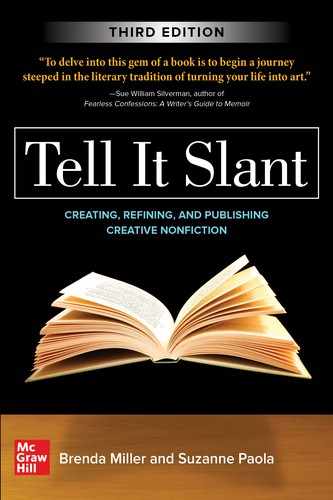Reading as a Writer
There’s no getting around it. Reading and writing go hand in hand. You cannot be a good writer without also being a good reader. You read to hear other writers’ voices, but you also read to tune up your own voice, to remember what gets you excited about writing in the first place. Through reading, you continually learn the craft all over again.
Throughout Tell It Slant, we refer to many fine essays to illustrate key points in writing creative nonfiction, and at the end of each chapter we provide a list to guide you in further reading (these lists are by no means a comprehensive accounting of great creative nonfiction!). Many of these readings are available online as well as in print. For your convenience, we’ve also compiled the following anthology with essays that illustrate a wide variety of the concepts we’ve introduced in this book.
Reading For Craft
The following questions can help focus your reading on craft, skills, style, and techniques. We suggest you read the essays once for content, then again with a few of these questions in mind. You can reflect on each of the essays in writing or in discussion with fellow learners.
You might also develop your own writing prompts from each reading. What skills would you like to practice? What content does the writing inspire in you?
Questions for Reading as a Writer
1. What are the major themes (ideas, moods, lessons) in this piece? Are there any minor themes as well? Do you see a motif (a recurring pattern or theme) in this piece?
2. What specific, small details stay in your mind? Why? What senses are involved in creating these details? How do these small details lead to larger ideas (or themes)?
3. Does the author use details or images to create metaphor or simile? Is the metaphor an effective way to communicate meaning?
4. What kind of rhythm (or voice) does the writer create? Is there variety in the sentence structure or line length? Read the piece aloud to get a sense of the writer’s voice.
5. Try to identify scenes (that include concrete writing) in contrast to reflection or expository writing (which tends to be more abstract). What is the balance between the two?
6. How does the writer suspend key moments in time? In other words, how do we linger in a scene that might take only a few moments in real life? Why do you think the writer suspended this particular moment?
7. What tenses does the writer use (present, past, future, speculative)? What are the effects of these tenses? How does the writer combine tenses to create layers of time?
8. What point of view does the writer use? Is it always from the first-person (I) point of view? Does the point of view remain the same throughout the piece? Does the narrator speak from a child’s perspective or an adult perspective? or both?
9. How does the writer structure the piece and to what effect? (Why does it begin where it does? Why does it end with the image or scene the writer chooses?)
10. Look at the transitions between paragraphs or between stanzas. How does the author make these transitions? What effect do they have on the forward momentum of the piece?
Questions for Creative Nonfiction in Particular
1. What is “creative” about “creative nonfiction”?
2. When does the “creative” part become “fiction”?
3. What ethical considerations must writers take into account?
4. How does a writer gain access to memory? How can this memory be represented both accurately and aesthetically?
5. How do writers incorporate research in creative nonfiction?
6. How do we overcome inhibition while writing in this genre?
7. How can personal stories become interesting to others? What makes them “universal?” Do they need to be? Are some stories relevant only for a particular audience?
